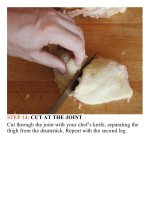The food lab better home cooking through science ( PDFDrive ) 456
Bạn đang xem bản rút gọn của tài liệu. Xem và tải ngay bản đầy đủ của tài liệu tại đây (221.92 KB, 2 trang )
• At 140°F and above, the salmon has reached its limit.
Fromhereonout,it’sjustgoingtogetchalkier,drier,and
more unattractive. This is what salmon that sits in the
steam table at the cafeteria looks like, and probably why
youdidn’tlikesalmonasakid.
So, your goal is really to keep as much of the salmon
below the 140°F temperature range (and, preferably, closer
to the 125°F range) as possible. To do this, make sure to
alwayscooksalmonskinonifyou’repan-roasting,evenif
you plan on serving it skinless.¶ By cooking salmon with
the skin on, you can alleviate any sort of overcooking
problems in the outer layers of flesh. The insulative
subcutaneous fat acts as a heat barrier, transmitting heat to
the interior flesh very, very slowly.This slow heat transfer
means that skin-on salmon cooks much more evenly and
gentlythanskinlesssalmon.Theskinfulfillstheexactsame
role that a batter or breading supplies on a piece of fried
chicken or a tempura shrimp—a buffer to slow down heat
transferandprovideacrispelementwhilekeepingtheflesh
underneathfromovercooking.
You may ask, butwhatabouttheothersideofthefillet?
A salmon fillet only has skin on one side, right?And right
youare.Westillhavethepotentialproblemofovercooking
the skinless side.The solution?Just cook it through almost
entirely with the skin side down . French chefs who want to
sound lofty like to call this unilateral cooking—cooking
fromonesideonly.Personally,Icheatjustabit,flippingthe
salmonoverforthelast15secondsorso,justtofirmupthe
secondside.Butcookingsalmonskin-ondoesleadtoafew
otherpossibleproblemsthatneedtobedealtwith.
THEWOESOFSKIN-ONFILLETS
First off, if you aren’t careful, youstill get the leaking
albuminproblemwithskin-onsalmonfillets.Evenworseis
thisguy:
Yep, don’t tell me that hasn’t happened to you. At its
worst,theskingetssolidlyfusedtotheskilletandthemeat
ends up completely separating from the skin as it cooks.
This is not a terrible thing if you don’t plan on eating the
skin, and indeed, if you want to serve a skinless fillet, it’s
thebestwaytodoit:cookthefilletskin-on,thenslideathin
spatulainbetweentheskinandthefleshtoseparatethem.
Atbest,youendupwithsomethingthatlookslikethis:









